Cuba, Part III – Cruising the North Coast

Cuba was great. After just one day of partying with the people we were Cuba-philes. Castro was a wonderful guy.
“Well, he must be, to supply all that cut-price beer and rum to the people!”
Then we set off to cruise the north coast of the country – and that was where things started to go wrong.
Before one sets off to cruise anywhere in Cuba one needs a permit (something that was missed on the Norwegian cruise line accident) – and the permit is supposed to list each and every place where the vessel will anchor.
Well… how can you possibly be expected to know where you will want to anchor on a coast where you have never sailed? It isn’t as if there was a line of harbours or bays neatly positioned, each a day’s sail from the next, all along Cuba’s north coast. On the contrary: after the first sixty miles or so the shore is guarded by a fragmented reef, with scattered pieces of sand-capped coral forming the only land. There are no harbours out here, away from the mainland, and even after a thorough appraisal of the chart and a careful reading of two Cruising Guides we were unable to say for sure where we might be anchored in a week’s time. In fact, we were not even sure which place would be our fist “port of call”.
To cover ourselves we compiled a typed list containing the names of every cay and every possible anchorage between Puerto de Vita and Havana. We expected that the authorities would scrutinise it carefully and cross off any places which were out of bounds, but instead the chief just grinned in delight – “What a good idea!” – and stapled a copy of the list onto our permit.
“So we can go anywhere,” we said to ourselves. “That’s great!”
Onward Clearance
Before departing from any Cuban port a vessel is required to clear out. Yes; the full rigmarole again, or most of it. First came the officious fellow, with his Guarda companion; he it was who stamped our forms, shook our hands warmly, and issued the permit. No doctor was required this time, and there was no representative from the Min of Ag, but the dog had to pay us another visit. Quite why we cannot imagine. Do they seriously think that anyone would be smuggling drugs OUT of Cuba, or along the Cuban coast…?
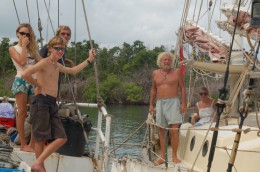
Eager to leave in good time we had asked the authorities to be aboard at the earliest possible opportunity, and they had agreed to board us at 08.30.
But we have been hanging out in Spanish-speaking parts of the world for quite a while now, and thus we were not at all surprised when the team duly rocked up at 11.30 sharp. Even then, they only made it before lunchtime because we sent a reminder – not once, but twice.
This sort of thing is really rather a bore. If a boat travels at five or six knots and you need to cover sixty miles and arrive at your destination well before nightfall then, clearly, you need to get away as early as possible – but you can explain this problem to tan officials as often as you like and it won’t make a scrap of difference.
They aren’t obstinate or even unintelligent; they just cannot relate to the idea of being stuck out on the ocean and having to reach to and fro, off a reef-strewn coast, for twelve nervous hours.
You can tell them all about coral-heads and good light until you are blue in the face, and all they will do is smile and nod – and then turn up when they feel like it.
And the one thing that they won’t do is let you stay until the following morning. No way, Jose! You’ve cleared out of this place, and so you must be off, prontissimo. They’ll even stand over you until you’ve untied your lines.
The only person we ever met who managed to beat the system was our friend Julian. Julian left Puerto de Vita on a falling tide and, despite an abundance of channel markers, somehow contrived to run his boat aground on a mud-bank. Thus – after a bit of a contretemps – the authorities had no choice but to let him stay until the following morning.
Where Next?
Three other inlets, lying west of Naranjo and Vita, offer themselves as suitable anchorages for a passing sailor; or at least, they seem to, from the look of the chart. Further investigation suggested that neither Puerto Padre, Bahía Manatí, nor Bahía de Nuevitas is currently an ideal venue for a visiting yacht. Padre is said to be a commercial port ruled by authorities who are very unenthusiastic about yotties; and at Manatí and Nuevitas, we were told, we would probably not be allowed ashore. Whether or not we were allowed ashore, we would be required to clear in and then, before leaving, we would have to clear out again.
Considering that our main objective was to reach the cays, and given that any halt which entailed a visit from the authorities could only mean delays, we decided to skip these ports and press on towards the first open anchorage: namely a lagoon which lies off the north shore of Cayo Romano. The lagoon is sheltered behind the barrier reef and access can only be gained at one point, towards the southern end of the cay, via a pass known as Quebrado Aguas del Inglés. (This seems to mean Rough Waters of the Englishman…).
Note that this pass is not named on the charts.
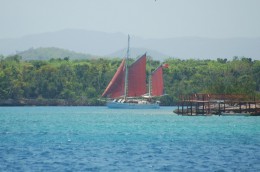
We eventually cleared the entrance to Bahía Vita at 12.15 – Mollymawk having negotiated the narrow, winding channel under mizzen and genoa, while Cherub came down just astern of us under full sail.
Now that the sun was smiling down we realised that the ria is actualy rather pretty. It’s a pity that one cannot anchor wherever one pleases… but perhaps that freedom will someday be possible, in some happy future time when Cuba and the US have settled their differences.
Determined to keep in close contact with Cherub, we set only a reefed main, and together the two boats swooped westward on the wings of a handy force five. Just to port lay the coast – a low smudge of greenish-grey – and to starboard lay a shipping lane. All we had to do was steer a course between them.
Count on a Current
The distance from Vita to the southern end of Cayo Romano is 110 miles, and so we knew that we could not possibly make the pass before nightfall; rather, we expected to arrive there during the following morning.
However, by 01.00, when I came on watch, it had became obvious that we were doing very much better than expected. We evidently had at least two knots of current under us.
If no action were taken then we must arrive at our destination before dawn, and so I dropped the main. Even so, we were still making six and a half knots through the water.
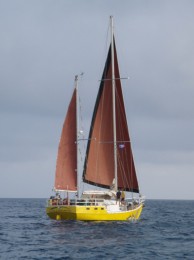
Cherub sailed gaily past. She was not wearing any lights but I could follow her progress on the radar. From the speed she was travelling at I inferred that her skipper had probably dozed off. I watched with increasing anxiety as a ship, leaving the lane and heading for Nuevitas, came thundering towards them.
“Cherub. Cherub. This is Mollymawk.”
No response. But that was no surprise as Paul’s battery was almost always flat.
Should I call the ship and alert them to the presence of the unlit yacht?
While I dallied, the dots on the radar moved closer and closer towards one another… until it became clear that the ship would, in fact, clear Cherub. It cleared her by all of 200 yards / metres.
At 05.00 we dropped the mizzen. Cherub was now three miles ahead of us and – so far as I could judge – seemed to be right off the pass. Was she going to sail straight on by? Beating back up against this current would be no fun at all.
And then, all of a sudden, the gaffer altered through 90 degrees and began heading out to sea.
“It’s lucky for you that you just happened to arrive there at dawn,” I said to Johnson, later that day. “Xoë tells me that you always wake at dawn.”
“Nonsense. Nonsense. I’d been awake since midnight.”
“Oh yes? And the ship…?”
“What ship? No ships around here.”

At 06.00 we tacked out towards Cherub. The sun, rising through a screen of cuddly clouds, cast a yellow glow over the sea and painted a wonderfully dramatic backdrop behind the ketch.
“Head in now, shall we?” Johnson called as we came within hail.
Not on yer life! Not yet.
“And to think he’s already lost two boats on a reef.”
“We’ll give it another hour,” Nick called back.
When the sun is high coral heads are easy to spot, but when the light is poor they are invisible. Nick, too, has already lost a boat on a reef; and he lost it precisely because he was travelling through reef-strewn waters in poor light.
Quebrado Aguas del Inglés and Cayo Romano
At half past eight we decided that the sun was high enough to light our way and so we tacked back in towards the pass. It was wide, and the waves breaking on the reef either side marked its edges very clearly.
We entered and then, with the admiral serving as look-out, high up on the pulpit, we worked our way into the lee of the reef.
On the following day we moved across towards the island, encountering only one isolated patch of coral before we arrived at a secondary reef off-lying the cay.
So far so good.
Cayo Romano is a vast, unspoiled island – a place as big as many of the Caribbean isles but with no one living aboard it. The lagoon where we had anchored was broad and fairly sheltered. The water was reasonably warm and perfectly clear.
If these are sufficient attractions, then the place is perfect.
During our two day visit no one troubled us; indeed, I would imagine that no one in the world even knew that we were here. The island is supposed to be Castro’s favourite retreat, but on our one foray shore, to the beach, we found no trace either of him nor of any other human beings.
Perhaps if we had been bolder, or had had more time, we might have explored the interior… but as it was we were content to chase the fish around the coral heads.
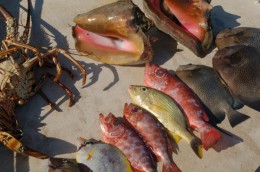
Xoë set to work with her home-made spear and caught twelve good-sized fish and one huge lobster.
Caesar rigged up the windsurfer for the first time in over a year and surfed to and fro.
Nick and Johnson got together to sample the new rum.
Roxanne found a huge puffer fish lurking in a cavity in the coral.
And I spotted an interesting cockle shell and then, just as I was about to pick it up, realised that it was actually the pectoral fin of a scorpion fish…!
Between the Devil and the Deep Blue Sea
From Cayo Romano we decided to head for Cayo Paredón, some 45 miles further west.
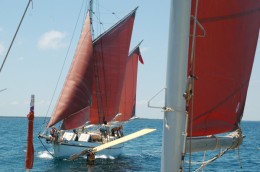
Satisfied that there were no coral heads between ourselves and the entrance, we set off early (before the light was “good”).
Again, the navigation for this next leg of our journey was perfectly straightforward but rather intensive. It would, of course, have been a lot less strightforward and considerably more intensive in the days before we had push-button toys to tell us our position. Given that the current varies according to the tide, so disrupting any DR, and given that the cays are low and featureless and that the reefs produce no radar echo, navigating along this coast would previously have been a full time job. As it was, we just pootled along in the hot sunshine, keeping the almost-invisible reef, to port, about a mile away and the completely invisible shipping lane to starboard.
We were running goose-winged before a gentle breeze (f2). Of course, yachts don’t really like to go directly down-wind – when you do that, everything crashes around – and so we had a choice either of closing the reef (by running on one gybe) or of sliding towards the lane (by running on the other).
Given that the shipping lane was empty of traffic we felt no qualms about closing, and then crossing the invisible line which marked its edge. Cherub, half a mile ahead of us, had already sidled out into the middle of the route which – according to the rules – was only to be travelled in the opposite direction. No matter.
“Oh heck!”
“What?”
“Isn’t that a coastguard vessel? Coming our way. Along the lane.”
“Oh shoot!”
The wind was so light that we had no hope of slipping out of the lane again before the warship was upon us.
“I wonder what the Cubans think of yotties who travel the wrong way up an international shipping lane.”
“If you do it in the Straits of Gibraltar you can get a 15,000 Euro fine.”
“Let’s tell them we’re lost.”
Don’t Mess with the US
We turned on the radio – and as we did so we suddenly realised that the ship was not actually a Cuban one at all. It was none other than the dear old US Coastguard!
“What the devil are they doing here!”
As ever, the US Coastguard wanted to know our name, our port of registration, our last port of call, our captain’s inside leg measurement and so forth, none of which is information that they are entitled to ask for – is it…?
“Ask them what the heck they think they’re up to, interfering in Cuban waters,” said I to the captain.
But the captain was concerned to behave in a manner least likely to provoke the big guys into threatening us with a fine.
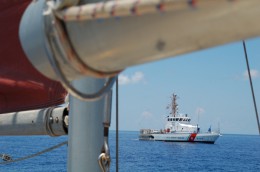
This interception took place immediately off a Cuban military post (on the island of Isla Confites). It is hard to see how the Cubans could interpret the presence of the US Coastguard right alongside their coast as being anything other than threatening, and I would guess that the paranoia which we witnessed over the ensuing week was due very largely to this “menace”.
Cayo Paredón
It was at Cayo Paredón that we first became aware of what we were up against.
The anchorage is tucked behind the island, so that it is very sheltered; the holding seemed to be good (in sand); the water was turquoise and quite warm; and the vista of flat, tree-covered islands was enlivened by a rather natty lighthouse, perched on the end of Paredón Grande.
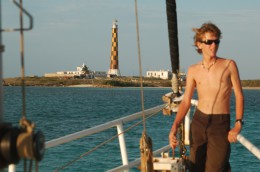
For want of anything better to do, we decided to row ashore and take a closer look at the yellow and black chequered lighthouse tower, but as we approached the beach five khaki-clad men appeared there. And they were not smiling.
“May we come ashore?” I asked.
“No!” they answered – in a manner which seemed to suggest that we ought to have known this.
“We’ve brought our papers with us. Do you want to see them?”
“No. Go away. Go to Cayo Coco; to the marina.”
And that was that.
The Crux of the Matter
Cayo Coco was not on our list of Places of Interest, because Cayo Coco is devoted entirely to tourism.
Indeed, I think that this lovely isolated isle provides a perfect demonstration of the Cuban authorities’ attitude towards foreigners. Since we want to come here, and since our coming brings them a much needed injection of funds, they have decided to let us in; but since they both fear and despise our deep-seated Capitalist ethics, and since they don’t want those ethics rubbing off onto their own good people, they have resolved to keep us apart.
Most visitors to Cuba will have purchased an all-inclusive holiday and will spend their week lying on the sand or playing in the water. Those few who want to take a look at the country can buy a seat on an official tour or else they can hire a car; that much is allowed to us. But folks arriving in their own homes and wandering around as they will, along the border, are perceived – in some vague way – as a threat to the country’s security. Castro can’t overlook the fact that any invasion is bound to come from the sea; and, after all, he and his fellow revolutionaries arrived here on the deck of a yacht!
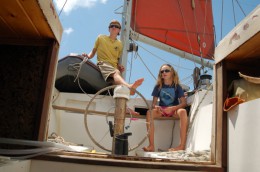
They want our money and – more than that – being of Spanish descent, and having Spanish manners, the Cubans actually want to be open towards us; but they just can’t quite bring themselves to trust us. The fact of the matter is that – being Communists, too – the authorities would like their tourists to behave in the same neat, orderly fashion as all masses should behave: they would like us to travel tidily from one secure, well-watched marina to the next.
Basically, Communist rulers are chronic control freaks.
Join us again in a fortnight for more info about Cruising Cuba and Coping with Uncompromising Comrades.
